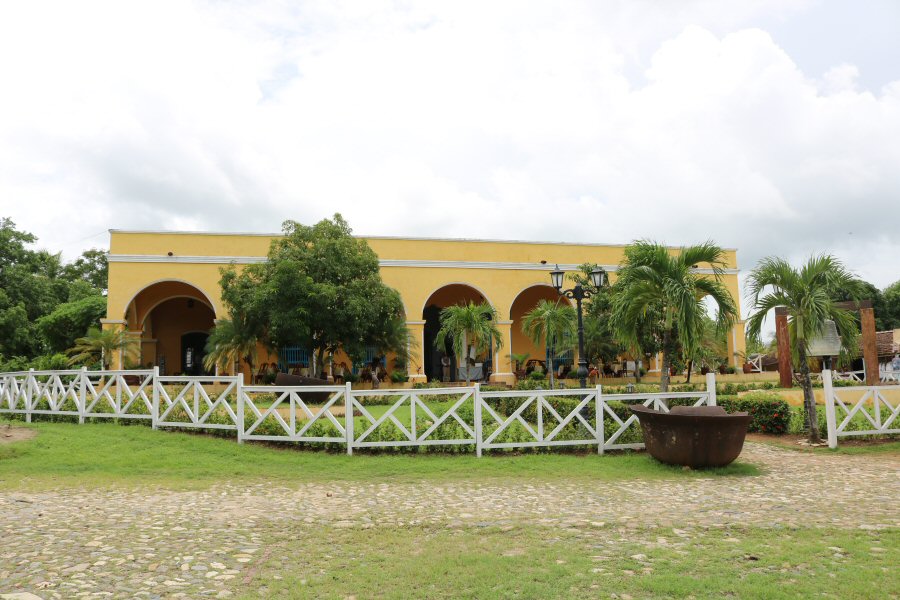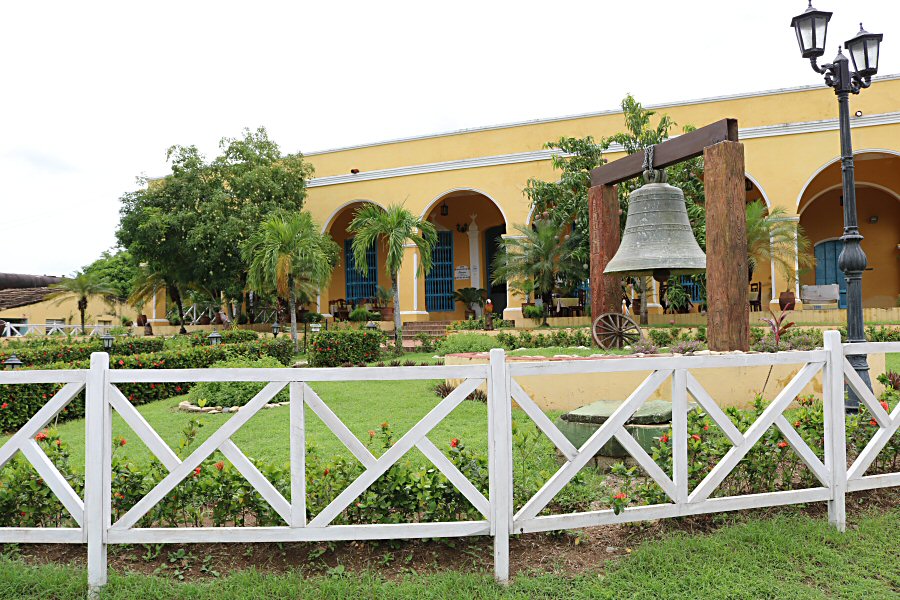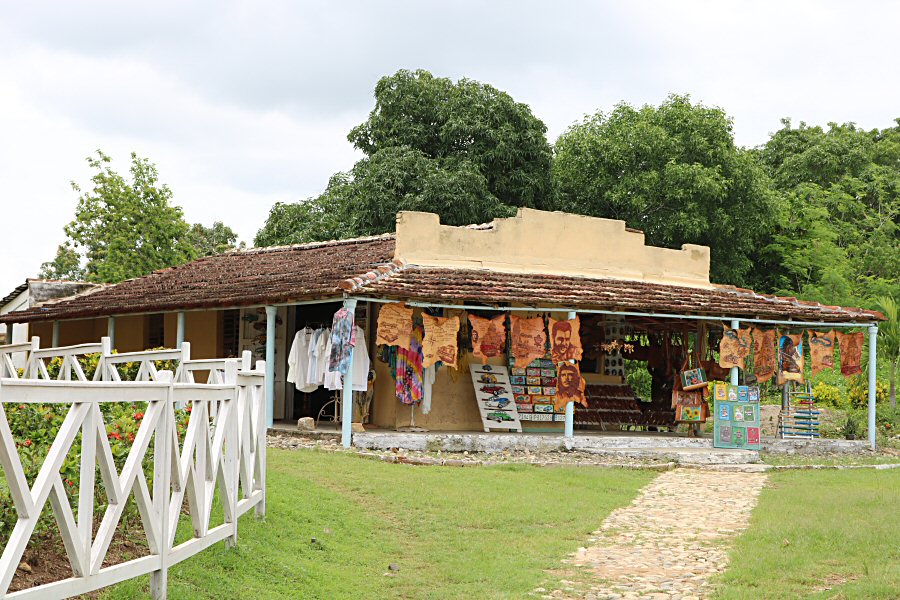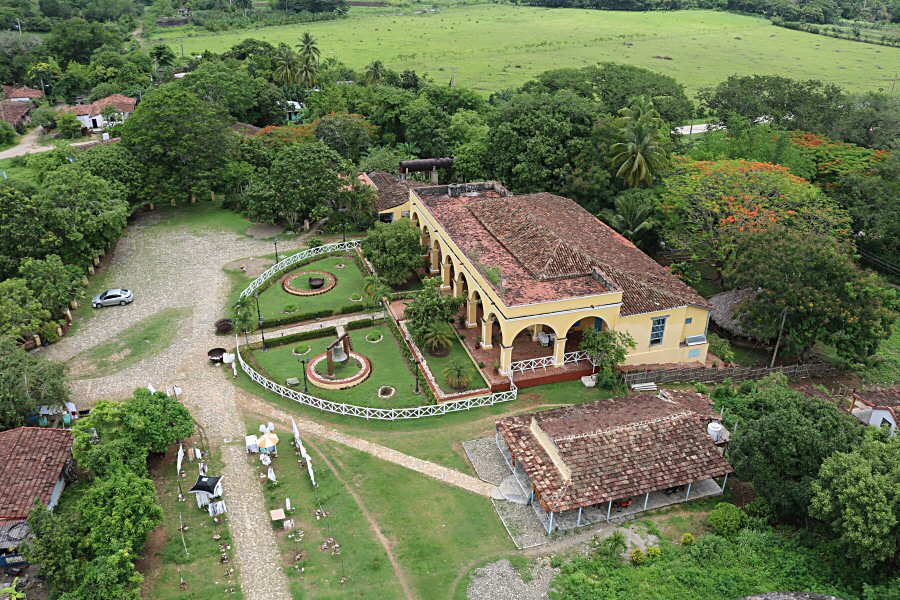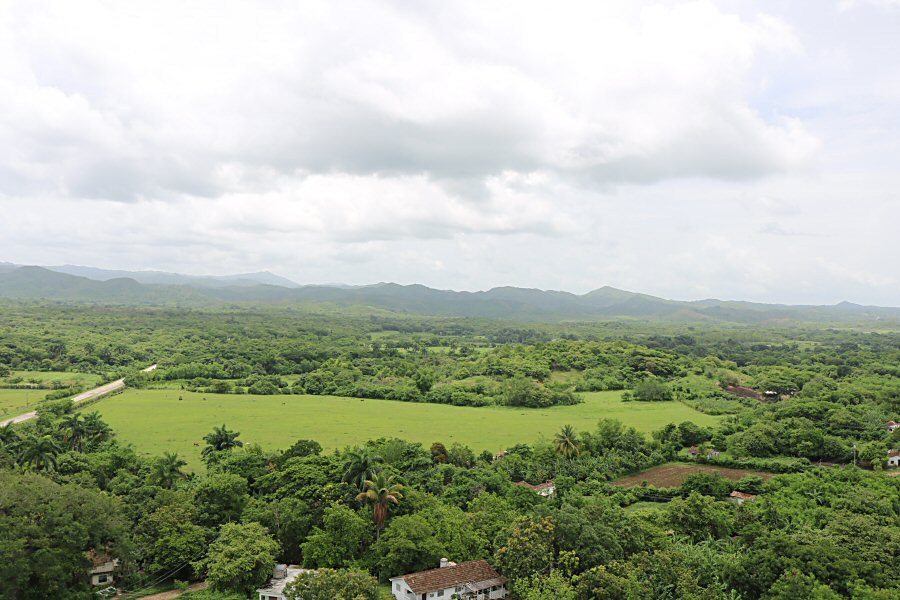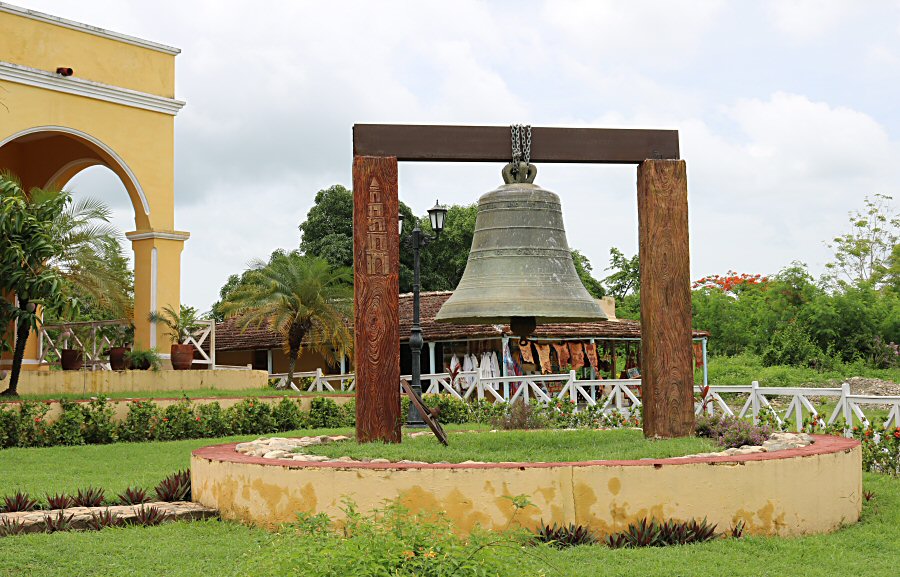
Architectural Features
The living museum, the Manaca-Iznaga sugar mill is one of the most frequented tourist destinations in the Valle de los Ingenios today. Currently, it became an emblematic place of the entire Valle de los Ingenios.
The farm was was made up of similar structures as other sugar-producing farms: a dwelling house (hacienda house) for its owner, the old slave quarters (barracones), a watchtower and a slave cemetery. The dwelling house at the end of a cobbled avenue has been converted into a restaurant, gift shop and bar, where you can taste Crfeole food, served up on the terrace overlooking a small garden. The barracones became family homes over time.
The tiny train station at Manaca-Iznaga is two minutes’ walk from the dwelling house and the tower. There is also a ship that was used as infirmary.
The Dwelling House
Although there is no exact date of the construction of the house, the architecture of the dwelling house corresponds to the construction patterns followed in the buildings of the city of Trinidad in the late 18th and early 19th centuries. The fact that its architecture is very similar to the Guáimaro hacienda house is shown as evidence that the dwelling house was built in the same time period.
The hacienda house has a beautiful façade formed by a portal which was rebuilt between 1989 and 1990. The construction of the portal was inspired by an engraving made by the famous engraver Eduardo Laplante in the 19th century, in which a large semicircular arcade draws attention. Innovations from the late 18th and early 19th centuries include the preference for more modern-looking arcs instead of the primitive portal consisting of wooden posts.
The portal of the dwelling house is supported by pillars on which the floor rested directly, It is covered with a hanging roof as extension of the roof of the building.
The floor plan of the building consists of two sections which are oriented parallel to the street. In the first section rooms for offices and recreation are located. The area was expanded transversely by adding rooms to both sides of the second section. Behind the house there is a hanging that rests on forks that are joined through wooden bars.
The Tower
There are different opinions about when the construction of the Manaca-Iznaga tower (Torre Vigía; watchtower), the most magnificent part of the farm, started and when it was completed. The tower is said to have been built in 1848, when the farm was the property of Juana Nepomuceno Hernández, widow of Alejo Iznaga y Borrell, or in 1826, at a cost of 10,000 pesos, although evidence suggests that construction of the tower began with the efforts of Alejo Iznaga y Borrel, the son of Pedro José Iznaga, in 1815 or latest in 1816.
When he died in 1845, his widow Juana Hernández de Rivera requested an appraisal of assets and an inventory of haciendas, in which the famous tower was already registered. Thus, it is understood that the construction of the tower was completed before this date.
The tower was completed in 1830.
A competition begins between Alejo Iznaga y Borrell, who continued to run the Manaca-Iznaga sugar mill after their father's death in 1814, and his brother Pedro. Soon, they bet on who would make the best investment in the farm. Pedro began to build a weel, near the dwelling house, with the idea of providing plenty of water for the farm. Alejo, on the other hand, embarked on the construction of a majestic tower to reflect the prestige of the family.
Hundreds of African slaves worked in the construction of the tower in continuous shifts under the whip of the foreman. Neither thirst, nor hunger, nor accidents, could stop the work. When the construction of the tower was completed, Alejo climbed to the top of the tower and declared his victory by ringing the bell with joy when he saw the shining line of the sea.
After a short while, water gushes out from the bottom of the well that Pedro had dug.
The Manaca-Iznaga tower was the accesible highest point in the so-called Valle de los Ingenios, from where every movement of the slaves could be seen even in the dozens of sugar factories that operated in the surrounding, even the foothills of the Escambray mountains.
The Manaca-Iznaga tower was the accesible highest point in the so-called Valle de los Ingenios, from where every movement of the slaves could be seen even in the dozens of sugar factories that operated in the surrounding, even the foothills of the Escambray mountains.
Although the Manaca-Iznaga tower was originally erected to watch over the working slaves on sugarcane plantations, another purpose was to demonstrate family Iznaga's power over its slaves and the significance of its owner in the sugar industry and local society, as it was the tallest structure with its height of 43,5 meters in Cuba at one time.
The watch tower functioned also as a bell tower. At dawn, the bell at the top of the tower was used to wake up the slaves with its nine bells of the Ave Maria to assist in agricultural work and in the afternoon, it would announce the end of the day for the slaves. Also, the Oración a la Santísima Virgen (Prayer to the Blessed Virgin) was recited by the slaves in the morning, noon, and afternoon, when the bell rang. When the great bells rang in a row, it would announce the fire in the extensive sugar cane fields, the escape of slaves or the frequent revolts of the slave masses at the bay. From the top of the tower the pirate ships could be seen along the south coast.
The living museum, the Manaca-Iznaga sugar mill is one of the most frequented tourist destinations in the Valle de los Ingenios today. Currently, it became an emblematic place of the entire Valle de los Ingenios.
The farm was was made up of similar structures as other sugar-producing farms: a dwelling house (hacienda house) for its owner, the old slave quarters (barracones), a watchtower and a slave cemetery. The dwelling house at the end of a cobbled avenue has been converted into a restaurant, gift shop and bar, where you can taste Crfeole food, served up on the terrace overlooking a small garden. The barracones became family homes over time.
The tiny train station at Manaca-Iznaga is two minutes’ walk from the dwelling house and the tower. There is also a ship that was used as infirmary.
The Dwelling House
Although there is no exact date of the construction of the house, the architecture of the dwelling house corresponds to the construction patterns followed in the buildings of the city of Trinidad in the late 18th and early 19th centuries. The fact that its architecture is very similar to the Guáimaro hacienda house is shown as evidence that the dwelling house was built in the same time period.
The hacienda house has a beautiful façade formed by a portal which was rebuilt between 1989 and 1990. The construction of the portal was inspired by an engraving made by the famous engraver Eduardo Laplante in the 19th century, in which a large semicircular arcade draws attention. Innovations from the late 18th and early 19th centuries include the preference for more modern-looking arcs instead of the primitive portal consisting of wooden posts.
The portal of the dwelling house is supported by pillars on which the floor rested directly, It is covered with a hanging roof as extension of the roof of the building.
The floor plan of the building consists of two sections which are oriented parallel to the street. In the first section rooms for offices and recreation are located. The area was expanded transversely by adding rooms to both sides of the second section. Behind the house there is a hanging that rests on forks that are joined through wooden bars.
The Tower
There are different opinions about when the construction of the Manaca-Iznaga tower (Torre Vigía; watchtower), the most magnificent part of the farm, started and when it was completed. The tower is said to have been built in 1848, when the farm was the property of Juana Nepomuceno Hernández, widow of Alejo Iznaga y Borrell, or in 1826, at a cost of 10,000 pesos, although evidence suggests that construction of the tower began with the efforts of Alejo Iznaga y Borrel, the son of Pedro José Iznaga, in 1815 or latest in 1816.
When he died in 1845, his widow Juana Hernández de Rivera requested an appraisal of assets and an inventory of haciendas, in which the famous tower was already registered. Thus, it is understood that the construction of the tower was completed before this date.
The tower was completed in 1830.
A competition begins between Alejo Iznaga y Borrell, who continued to run the Manaca-Iznaga sugar mill after their father's death in 1814, and his brother Pedro. Soon, they bet on who would make the best investment in the farm. Pedro began to build a weel, near the dwelling house, with the idea of providing plenty of water for the farm. Alejo, on the other hand, embarked on the construction of a majestic tower to reflect the prestige of the family.
Hundreds of African slaves worked in the construction of the tower in continuous shifts under the whip of the foreman. Neither thirst, nor hunger, nor accidents, could stop the work. When the construction of the tower was completed, Alejo climbed to the top of the tower and declared his victory by ringing the bell with joy when he saw the shining line of the sea.
After a short while, water gushes out from the bottom of the well that Pedro had dug.
The Manaca-Iznaga tower was the accesible highest point in the so-called Valle de los Ingenios, from where every movement of the slaves could be seen even in the dozens of sugar factories that operated in the surrounding, even the foothills of the Escambray mountains.
The Manaca-Iznaga tower was the accesible highest point in the so-called Valle de los Ingenios, from where every movement of the slaves could be seen even in the dozens of sugar factories that operated in the surrounding, even the foothills of the Escambray mountains.
Although the Manaca-Iznaga tower was originally erected to watch over the working slaves on sugarcane plantations, another purpose was to demonstrate family Iznaga's power over its slaves and the significance of its owner in the sugar industry and local society, as it was the tallest structure with its height of 43,5 meters in Cuba at one time.
The watch tower functioned also as a bell tower. At dawn, the bell at the top of the tower was used to wake up the slaves with its nine bells of the Ave Maria to assist in agricultural work and in the afternoon, it would announce the end of the day for the slaves. Also, the Oración a la Santísima Virgen (Prayer to the Blessed Virgin) was recited by the slaves in the morning, noon, and afternoon, when the bell rang. When the great bells rang in a row, it would announce the fire in the extensive sugar cane fields, the escape of slaves or the frequent revolts of the slave masses at the bay. From the top of the tower the pirate ships could be seen along the south coast.
The Manaca-Iznaga tower has also a legend that was created due
to the love affair between the Iznaga brothers, Pedro and Alejo.
They fell in love with the same young woman, so that they
started a bet to build the most magnificent structure that would
express their feelings to the young woman. Alejo raised the
43,5-meter tower, while Pedro drilled a 28-meter deep well,
which still is used by the inhabitants of the valley.
There is also another rumor that is somewhat based on reality. Great happiness reigned in the Manaca-Iznaga hacienda when Alejo, who was in his fifties, married Juana Nepomuceno Hernández, a very beautiful young woman from the Trinidad aristocracy. The woman had a statuesque body, matte white skin, and eyes as black as her hair. Her flirtatious smile, elegance, and graceful gestures made her worthy of the love and respect of everyone who knew her. The huge dwelling house received a magical touch with the arrival of Juana. The nights became more beautiful when her delicate hands glided over the keyboard of the old German piano and the notes of the waltzes and rigadoons spread throughout the valley.
Years later, Alejo noticed a young man who passed every afternoon in front of the house, mounted on a spirited steed. Driven mad with jealousy, Alejo challenged him to a duel and caused him a mortal wound. Soon, Alejo locked his unhappy wife on the penultimate floor of the tower, through whose oval skylights she could see the green fields of cane and the distant mountains. As a result of this isolation, his wife lost her mind and the desire to live until she died.
Hence the legend arises of the ghost of a woman in white wandering that place at night. The neighbors started to talk about a white silhouette floated on one of the top floors of the tower, when the tower was illuminated by the moon at nights. When you approached the windows of the tower, a beautiful woman's face appeared, framed by black hair, furrowed by traces that reflected horror and pain, and tears flew from her eyes. Amid the wails of a sweet voice, screams were heard imploring help to get out of the confinement.
In 1887, the railings, the stairs and the wooden floors (the mezzanines) were restored, improving the condition of the top tourist attraction in the whole valley.
The Manaca-Iznaga sugar mill with its famous watch tower was declared a National Monument in 1978, and a World Heritage Site by UNESCO in 1988, considering it a historical treasure.
The tower was built with baked clay bricks, traditional lime and sand mostar, apparently processed for months to provide it with resistance to natural disasters such as tornadoes and hurricanes. It is a soldid structure that has sevel levels, inteconnected with an interior wooden staircase. The levels are in geometric shape, ranging from square to octagon. Each level has also spacious arches. To achieve the best view of the valley, you have to climb 184 steps up to the top that was crowned by a bell tower. The large bell that once crowned the top, rests in front of the dwelling house now. It was cast in Trinidad by José Giroud. On the bell you can read the inscription: “Buena Vista Sugar Mill of Don Justo Germán Cantero”.
Some visitors may not want to use the precarious wooden staircase to climb one of the seven levels of this 43,5-metre-high tower, but if they knew they'd see the whole valley from here, so that they could empathize with the slaves who once worked under so many persecutions on the plantations there, they would do it. Also, it is worth to see the entire valley, its natural beauty and the country atmosphere. It is an excellent time to take beautiful snapshots, relax and breathe some fresh air.
Furthermore, this region is known for its lacework, and women sell a variety of such as tablecloths, napkins, and even shirts, along the cobblestone path that leads to the bell tower. Lingerie, embroidery, weaving and working with natural fibers are traditions that retain their vitality there and are another of the attractions of the place for tourists and other visitors.
The slave huts in which erstwhile 231 slaves lived together, were independent constructions with wooden roofs in which a courtyard was reserved for the breeding of farm animals for the use of slaves. They were separate from the hacienda, but close enough that overseers could keep watch from the bell tower.
You can also take the opportunity to taste the fresh guarapo from sugar cane.
There is also another rumor that is somewhat based on reality. Great happiness reigned in the Manaca-Iznaga hacienda when Alejo, who was in his fifties, married Juana Nepomuceno Hernández, a very beautiful young woman from the Trinidad aristocracy. The woman had a statuesque body, matte white skin, and eyes as black as her hair. Her flirtatious smile, elegance, and graceful gestures made her worthy of the love and respect of everyone who knew her. The huge dwelling house received a magical touch with the arrival of Juana. The nights became more beautiful when her delicate hands glided over the keyboard of the old German piano and the notes of the waltzes and rigadoons spread throughout the valley.
Years later, Alejo noticed a young man who passed every afternoon in front of the house, mounted on a spirited steed. Driven mad with jealousy, Alejo challenged him to a duel and caused him a mortal wound. Soon, Alejo locked his unhappy wife on the penultimate floor of the tower, through whose oval skylights she could see the green fields of cane and the distant mountains. As a result of this isolation, his wife lost her mind and the desire to live until she died.
Hence the legend arises of the ghost of a woman in white wandering that place at night. The neighbors started to talk about a white silhouette floated on one of the top floors of the tower, when the tower was illuminated by the moon at nights. When you approached the windows of the tower, a beautiful woman's face appeared, framed by black hair, furrowed by traces that reflected horror and pain, and tears flew from her eyes. Amid the wails of a sweet voice, screams were heard imploring help to get out of the confinement.
In 1887, the railings, the stairs and the wooden floors (the mezzanines) were restored, improving the condition of the top tourist attraction in the whole valley.
The Manaca-Iznaga sugar mill with its famous watch tower was declared a National Monument in 1978, and a World Heritage Site by UNESCO in 1988, considering it a historical treasure.
The tower was built with baked clay bricks, traditional lime and sand mostar, apparently processed for months to provide it with resistance to natural disasters such as tornadoes and hurricanes. It is a soldid structure that has sevel levels, inteconnected with an interior wooden staircase. The levels are in geometric shape, ranging from square to octagon. Each level has also spacious arches. To achieve the best view of the valley, you have to climb 184 steps up to the top that was crowned by a bell tower. The large bell that once crowned the top, rests in front of the dwelling house now. It was cast in Trinidad by José Giroud. On the bell you can read the inscription: “Buena Vista Sugar Mill of Don Justo Germán Cantero”.
Some visitors may not want to use the precarious wooden staircase to climb one of the seven levels of this 43,5-metre-high tower, but if they knew they'd see the whole valley from here, so that they could empathize with the slaves who once worked under so many persecutions on the plantations there, they would do it. Also, it is worth to see the entire valley, its natural beauty and the country atmosphere. It is an excellent time to take beautiful snapshots, relax and breathe some fresh air.
Furthermore, this region is known for its lacework, and women sell a variety of such as tablecloths, napkins, and even shirts, along the cobblestone path that leads to the bell tower. Lingerie, embroidery, weaving and working with natural fibers are traditions that retain their vitality there and are another of the attractions of the place for tourists and other visitors.
The slave huts in which erstwhile 231 slaves lived together, were independent constructions with wooden roofs in which a courtyard was reserved for the breeding of farm animals for the use of slaves. They were separate from the hacienda, but close enough that overseers could keep watch from the bell tower.
You can also take the opportunity to taste the fresh guarapo from sugar cane.
